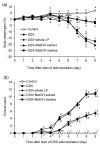Citrus limon Peel Powder Reduces Intestinal Barrier Defects and Inflammation in a Colitic Murine Experimental Model
- PMID: 33503995
- PMCID: PMC7912126
- DOI: 10.3390/foods10020240
Citrus limon Peel Powder Reduces Intestinal Barrier Defects and Inflammation in a Colitic Murine Experimental Model
Abstract
This study examines the ameliorative effects of lemon (Citrus limon) peel (LP) powder on intestinal inflammation and barrier defects in dextran sulfate sodium (DSS)-induced colitic mice. The whole LP powder was fractionated into methanol (MetOH) extract and its extraction residue (MetOH residue), which were rich in polyphenolic compounds and dietary fibers, respectively. Mice were fed diets containing whole LP powder, MetOH extract, and MetOH residue for 16 d. DSS administration for 9 d induced bodyweight loss, reduced colon length, reduced the colonic expression of tight junction proteins including zonula occludens-1 and -2, and claudin-3 and -7, and upregulated colonic mRNA expression of interleukin 6, chemokine (C-X-C motif) ligand 2, and C-C motif chemokine ligand 2. Feeding LP powder restored these abnormalities, and the MetOH residue, but not MetOH extract, also showed similar restorations. Feeding LP powder and MetOH residue increased fecal concentrations of acetate and n-butyrate. Taken together, LP powder reduced intestinal damage through the protection of tight junction barriers and suppressed an inflammatory reaction in colitic mice. These results suggest that acetate and n-butyrate produced from the microbial metabolism of dietary fibers in LP powder contributed to reducing colitis.
Keywords: colitis; dietary fiber; inflammatory cytokine; lemon peel; tight junction.
Conflict of interest statement
The authors declare no conflict of interest. The funders had no role in the design of the study; in the collection, analyses, or interpretation of data; in the writing of the manuscript, or in the decision to publish the results.
Figures







Similar articles
-
Citrus kawachiensis Peel Powder Reduces Intestinal Barrier Defects and Inflammation in Colitic Mice.J Agric Food Chem. 2018 Oct 24;66(42):10991-10999. doi: 10.1021/acs.jafc.8b03511. Epub 2018 Oct 11. J Agric Food Chem. 2018. PMID: 30277770
-
Resveratrol Ameliorates Intestinal Barrier Defects and Inflammation in Colitic Mice and Intestinal Cells.J Agric Food Chem. 2018 Dec 5;66(48):12666-12674. doi: 10.1021/acs.jafc.8b04138. Epub 2018 Nov 20. J Agric Food Chem. 2018. PMID: 30426751
-
Supplemental psyllium fibre regulates the intestinal barrier and inflammation in normal and colitic mice.Br J Nutr. 2017 Nov;118(9):661-672. doi: 10.1017/S0007114517002586. Br J Nutr. 2017. PMID: 29185927
-
Brazilian propolis extract reduces intestinal barrier defects and inflammation in a colitic mouse model.Nutr Res. 2019 Sep;69:30-41. doi: 10.1016/j.nutres.2019.07.003. Epub 2019 Jul 30. Nutr Res. 2019. PMID: 31470289
-
Final report on the safety assessment of capsicum annuum extract, capsicum annuum fruit extract, capsicum annuum resin, capsicum annuum fruit powder, capsicum frutescens fruit, capsicum frutescens fruit extract, capsicum frutescens resin, and capsaicin.Int J Toxicol. 2007;26 Suppl 1:3-106. doi: 10.1080/10915810601163939. Int J Toxicol. 2007. PMID: 17365137 Review.
Cited by
-
Panduratin A mitigates inflammation and oxidative stress in DSS-induced colitis mice model.Future Sci OA. 2024 Dec;10(1):2428129. doi: 10.1080/20565623.2024.2428129. Epub 2024 Nov 19. Future Sci OA. 2024. PMID: 39559852 Free PMC article.
-
Green Extraction Techniques for Obtaining Bioactive Compounds from Mandarin Peel (Citrus unshiu var. Kuno): Phytochemical Analysis and Process Optimization.Foods. 2021 May 11;10(5):1043. doi: 10.3390/foods10051043. Foods. 2021. PMID: 34064619 Free PMC article.
-
Functional Ingredients and Additives from Lemon by-Products and Their Applications in Food Preservation: A Review.Foods. 2023 Mar 4;12(5):1095. doi: 10.3390/foods12051095. Foods. 2023. PMID: 36900612 Free PMC article. Review.
-
Effects of Chenpi (Citrus reticulata cv. Chachiensis) on serum antioxidant enzymes, inflammatory factors, and intestinal health in Beagle dogs.Front Microbiol. 2025 Jan 7;15:1415860. doi: 10.3389/fmicb.2024.1415860. eCollection 2024. Front Microbiol. 2025. PMID: 39839098 Free PMC article.
-
Fermented Foods in the Management of Obesity: Mechanisms of Action and Future Challenges.Int J Mol Sci. 2023 Jan 31;24(3):2665. doi: 10.3390/ijms24032665. Int J Mol Sci. 2023. PMID: 36768984 Free PMC article. Review.
References
-
- Ng S.C., Shi H.Y., Hamidi N., Underwood F.E., Tang W., Benchimol E.I., Panaccione R., Ghosh S., Wu J.C.Y., Chan F.K.L., et al. Worldwide incidence and prevalence of inflammatory bowel disease in the 21st century: A systematic review of population-based studies. Lancet. 2018;390:2769–2778. doi: 10.1016/S0140-6736(17)32448-0. - DOI - PubMed
Grants and funding
LinkOut - more resources
Full Text Sources
Other Literature Sources

